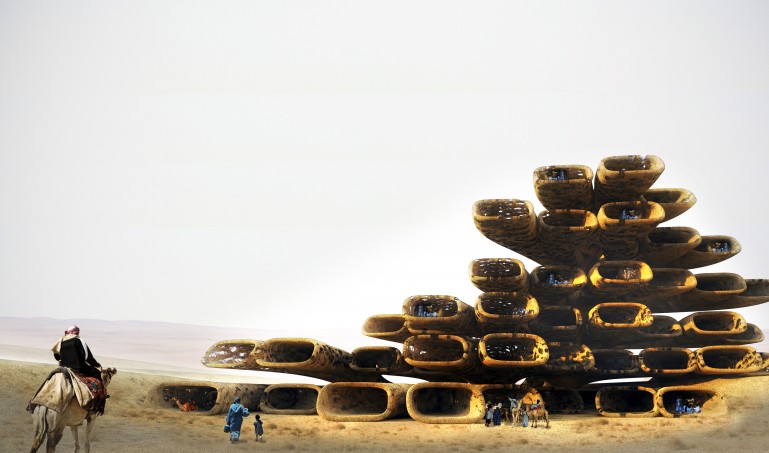Deserts are already abundant with sand, so why not construct buildings out of it? This was the thought behind Flohara, a collection of shelters Paris-based firm XTU Architects thought up for the Morocco Pavilion in the 2014 Venice Biennale.
The firm marketed the idea as a way to construct a city in the Sahara, a step toward making deserts more habitable and sustainable, as the need to transport additional building material is decreased (water, on the other hand, is another story).
Gizmodo reports that the construction of shelters using the method developed by XTU Architects can be broken down in three steps. First, “bubbles” that function as support skeletons for building upon must be inflated and placed in the desired site toward the wind. Next, sand, water, a hydogel, and the bacteria Sporosarcina pasteurii (which hardens sand) is mixed and sprayed onto the bubbles. Finally, the structure will be left alone as the sand and sun slowly build and harden the structure before the bubble is deflated.
Read more at Gizmodo.


Related Stories
| May 17, 2013
5 things AEC pros need to know about low-e glass
Low-emissivity glasses are critical to making today’s buildings brighter, more energy-efficient, and more sustainable. Here are five tips to help AEC professionals understand the differences among low-e glasses and their impact on building performance.
| May 14, 2013
Paints and coatings: The latest trends in sustainability
When it comes to durability, a 50-year building design ideally should include 50-year coatings. Many building products consume substantial amounts of energy, water, and petrochemicals during manufacture, but they can make up for it in the operations phase. The same should be expected from architectural coatings.
| May 9, 2013
10 high-efficiency plumbing fixtures
From a "no sweat" toilet to a deep-well lavatory, here's a round up of the latest high-efficiency plumbing fixtures.
| May 3, 2013
5 common failures in paints and coatings
As experienced designers, contractors, and owners know, most paint and coating problems are correctable, but some are especially stubborn to address. Here is a partial compendium of typical failure modes and methods for addressing the problem.
| May 3, 2013
Another edible city? Artist creates model city with chewing gum
French artist Jeremy Laffon pieced together a model city with thousands of sticks of mint-green chewing gum.
| Apr 26, 2013
BASF Corporation joins WDMA
The Window and Door Manufacturers Association (WDMA) announced today that the BASF Corporation is the newest member of the association.
| Apr 23, 2013
Building material innovation: Concrete cloth simplifies difficult pours
Milliken recently debuted a flexible fabric that allows for concrete installations on slopes, in water, and in other hard to reach places—without the need for molds or mixing.
| Apr 16, 2013
5 projects that profited from insulated metal panels
From an orchid-shaped visitor center to California’s largest public works project, each of these projects benefited from IMP technology.

















